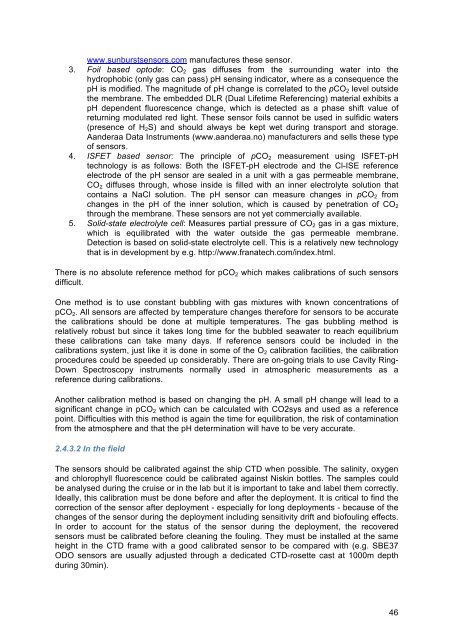Handbook of best practices
Handbook%20of%20best%20practices
Handbook%20of%20best%20practices
You also want an ePaper? Increase the reach of your titles
YUMPU automatically turns print PDFs into web optimized ePapers that Google loves.
www.sunburstsensors.com manufactures these sensor.<br />
3. Foil based optode: CO 2 gas diffuses from the surrounding water into the<br />
hydrophobic (only gas can pass) pH sensing indicator, where as a consequence the<br />
pH is modified. The magnitude <strong>of</strong> pH change is correlated to the pCO 2 level outside<br />
the membrane. The embedded DLR (Dual Lifetime Referencing) material exhibits a<br />
pH dependent fluorescence change, which is detected as a phase shift value <strong>of</strong><br />
returning modulated red light. These sensor foils cannot be used in sulfidic waters<br />
(presence <strong>of</strong> H 2 S) and should always be kept wet during transport and storage.<br />
Aanderaa Data Instruments (www.aanderaa.no) manufacturers and sells these type<br />
<strong>of</strong> sensors.<br />
4. ISFET based sensor: The principle <strong>of</strong> pCO 2 measurement using ISFET-pH<br />
technology is as follows: Both the ISFET-pH electrode and the Cl-ISE reference<br />
electrode <strong>of</strong> the pH sensor are sealed in a unit with a gas permeable membrane,<br />
CO 2 diffuses through, whose inside is filled with an inner electrolyte solution that<br />
contains a NaCl solution. The pH sensor can measure changes in pCO 2 from<br />
changes in the pH <strong>of</strong> the inner solution, which is caused by penetration <strong>of</strong> CO 2<br />
through the membrane. These sensors are not yet commercially available.<br />
5. Solid-state electrolyte cell: Measures partial pressure <strong>of</strong> CO 2 gas in a gas mixture,<br />
which is equilibrated with the water outside the gas permeable membrane.<br />
Detection is based on solid-state electrolyte cell. This is a relatively new technology<br />
that is in development by e.g. http://www.franatech.com/index.html.<br />
There is no absolute reference method for pCO 2 which makes calibrations <strong>of</strong> such sensors<br />
difficult.<br />
One method is to use constant bubbling with gas mixtures with known concentrations <strong>of</strong><br />
pCO 2 . All sensors are affected by temperature changes therefore for sensors to be accurate<br />
the calibrations should be done at multiple temperatures. The gas bubbling method is<br />
relatively robust but since it takes long time for the bubbled seawater to reach equilibrium<br />
these calibrations can take many days. If reference sensors could be included in the<br />
calibrations system, just like it is done in some <strong>of</strong> the O 2 calibration facilities, the calibration<br />
procedures could be speeded up considerably. There are on-going trials to use Cavity Ring-<br />
Down Spectroscopy instruments normally used in atmospheric measurements as a<br />
reference during calibrations.<br />
Another calibration method is based on changing the pH. A small pH change will lead to a<br />
significant change in pCO 2 which can be calculated with CO2sys and used as a reference<br />
point. Difficulties with this method is again the time for equilibration, the risk <strong>of</strong> contamination<br />
from the atmosphere and that the pH determination will have to be very accurate.<br />
2.4.3.2 In the field<br />
The sensors should be calibrated against the ship CTD when possible. The salinity, oxygen<br />
and chlorophyll fluorescence could be calibrated against Niskin bottles. The samples could<br />
be analysed during the cruise or in the lab but it is important to take and label them correctly.<br />
Ideally, this calibration must be done before and after the deployment. It is critical to find the<br />
correction <strong>of</strong> the sensor after deployment - especially for long deployments - because <strong>of</strong> the<br />
changes <strong>of</strong> the sensor during the deployment including sensitivity drift and bi<strong>of</strong>ouling effects.<br />
In order to account for the status <strong>of</strong> the sensor during the deployment, the recovered<br />
sensors must be calibrated before cleaning the fouling. They must be installed at the same<br />
height in the CTD frame with a good calibrated sensor to be compared with (e.g. SBE37<br />
ODO sensors are usually adjusted through a dedicated CTD-rosette cast at 1000m depth<br />
during 30min).<br />
46


